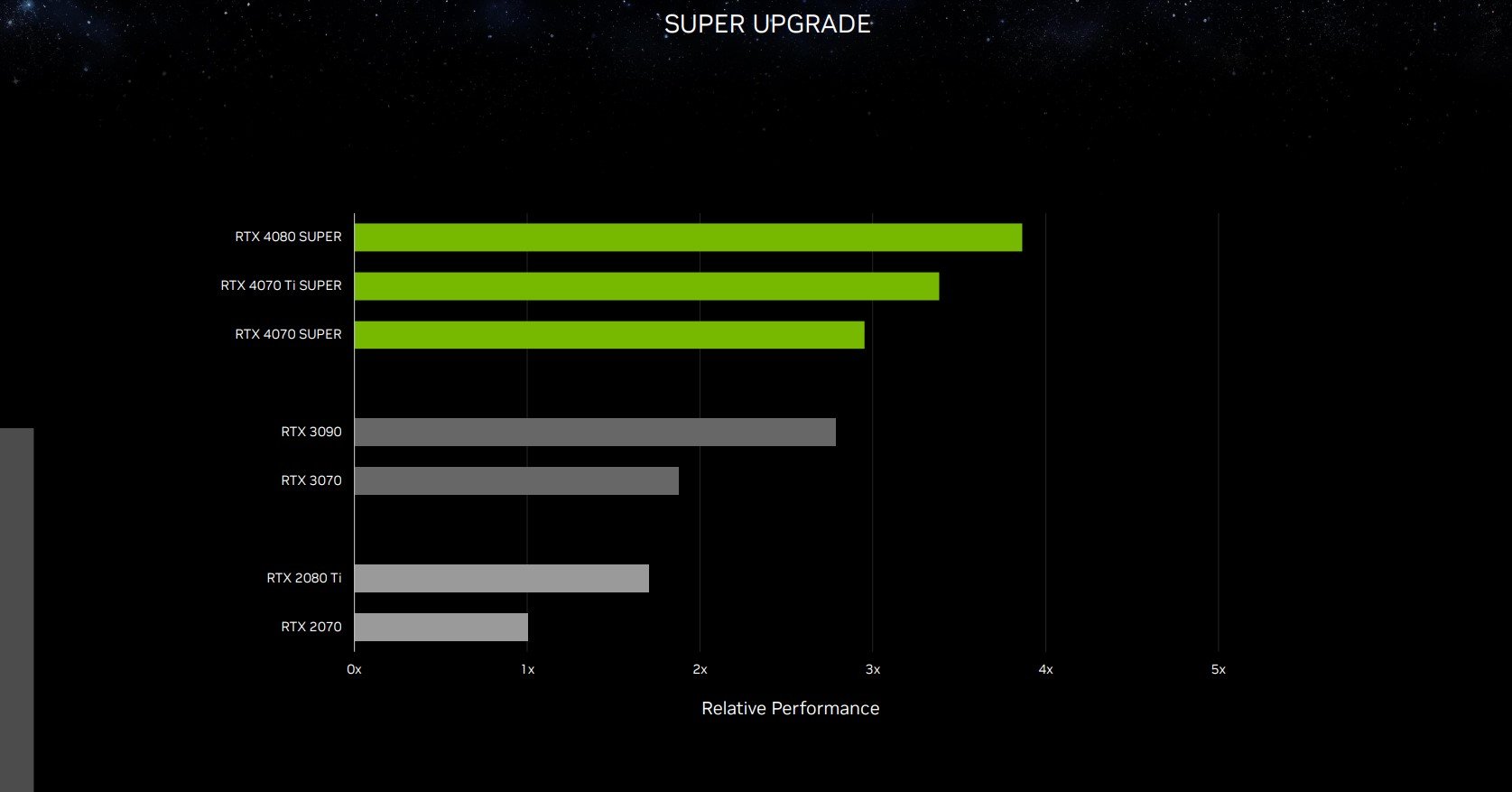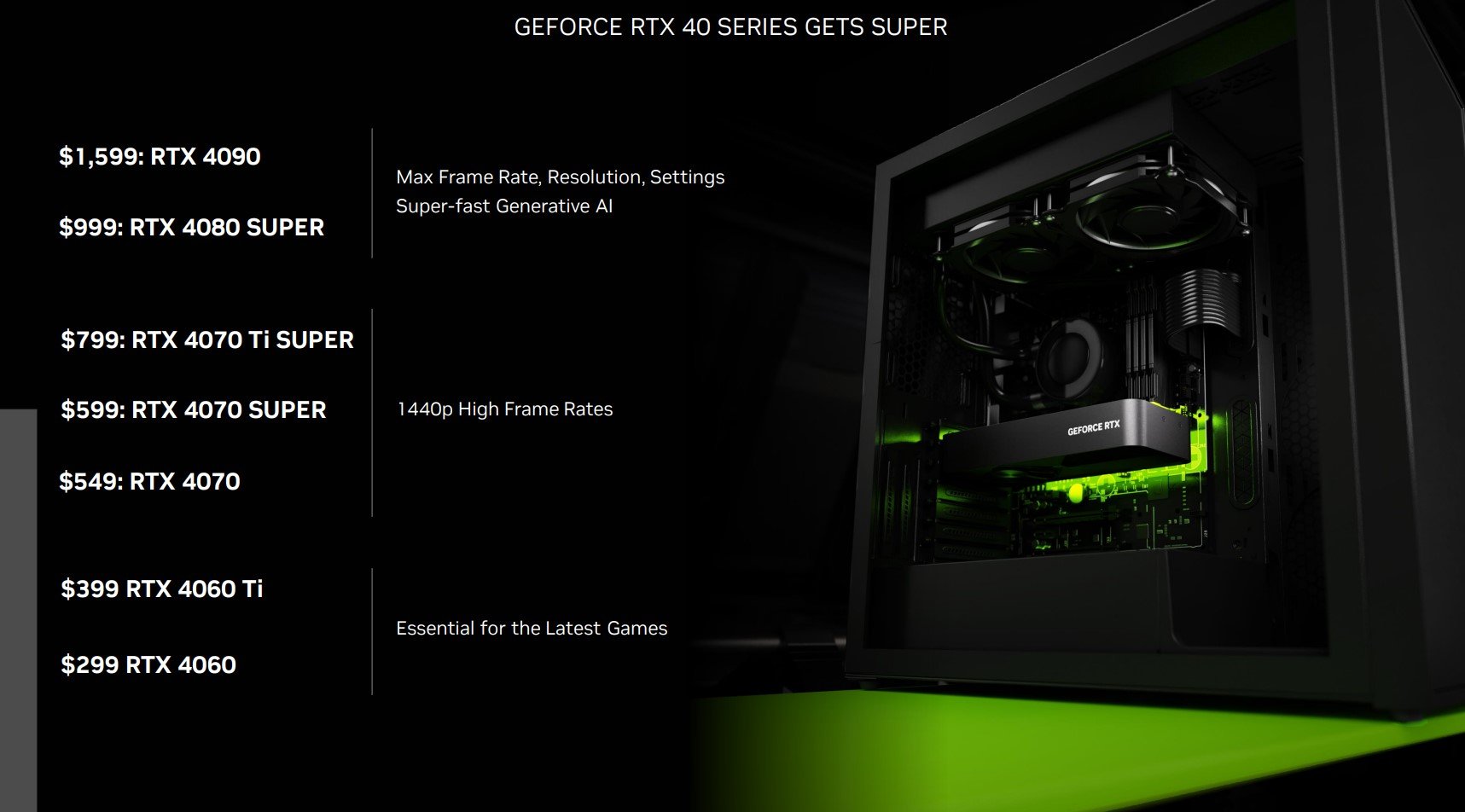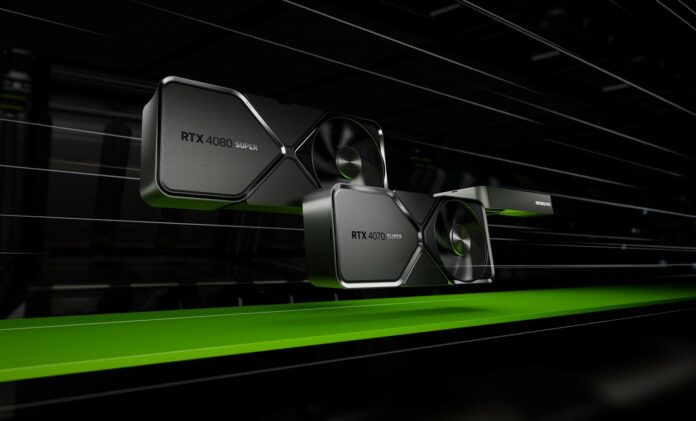Today at CES 2024, Nvidia unveiled a trio of GeForce RTX 40 Series Super cards sporting varying performance improvements over their in-market non-Super predecessors. Depending upon model, there are more cores, higher frequencies, and faster / more memory. Enter GeForce RTX 4070 Super, RTX 4070 Ti Super, and RTX 4080 Super.
This mid-cycle refresh aims to boost the attractiveness of GeForce RTX 40 Series cards through sensible performance additions set against the backdrop of maintaining or even cutting existing recommended pricing. The easiest method of discerning improvements is by delineation via the Club386 Table of Doom™.
| GeForce RTX | 4080 Super | 4080 | 4070 Ti Super | 4070 Ti | 4070 Super | 4070 |
|---|---|---|---|---|---|---|
| Launch date | Jan 2024 | Nov 2022 | Jan 2024 | Jan 2023 | Jan 2024 | Apr 2023 |
| Codename | AD103 | AD103 | AD103 | AD104 | AD104 | AD104 |
| Transistors (bn) | 45.9 | 45.9 | 45.9 | 35.8 | 35.8 | 35.8 |
| SMs | 80 of 80 | 76 of 80 | 66 of 80 | 60 of 60 | 56 of 60 | 46 of 60 |
| CUDA cores | 10,240 | 9,728 | 8,448 | 7,680 | 7,168 | 5,888 |
| Boost clock (MHz) | 2,550 | 2,505 | 2,610 | 2,610 | 2,475 | 2,475 |
| Peak FP32 TFLOPS | 52 | 48.7 | 44 | 40.1 | 36 | 29.1 |
| RT cores | 80 | 76 | 66 | 60 | 56 | 46 |
| Tensor cores | 320 | 304 | 264 | 240 | 224 | 184 |
| ROPs | 112 | 112 | 112 | 80 | 80 | 64 |
| Texture units | 320 | 304 | 264 | 240 | 224 | 184 |
| Memory size (GB) | 16 | 16 | 16 | 12 | 12 | 12 |
| Memory type | GDDR6X | GDDR6X | GDDR6X | GDDR6X | GDDR6X | GDDR6X |
| Memory bus (bits) | 256 | 256 | 256 | 192 | 192 | 192 |
| Memory clock (Gbps) | 23 | 22.4 | 21 | 21 | 21 | 21 |
| Bandwidth (GB/s) | 736 | 717 | 672 | 504 | 504 | 504 |
| Power (watts) | 320 | 320 | 285 | 285 | 220 | 200 |
| Launch MSRP ($) | 999 | 1,199 | 799 | 799 | 599 | 599 |
Analysis
Let’s be clear at the outset. Nvidia isn’t positioning the trio as immediate replacements for non-Super cards. Rather, the company views the latest models as attractive options for gamers looking to upgrade older graphics cards from, say, the RTX 20 Series generation. And if they take a tad more market share from rival Radeon, so much the better.

Starting off with RTX 4070 Super, which is the first card coming to market on January 17, Nvidia maintains the current $599 MSRP of RTX 4070 but invites gamers through uplifting performance by adding over 20 per cent more cores. This is possible as the underlying AD104 die has plenty of scope for augmented models. RTX 4070 Super raises the base card’s 5,888 cores / 46 SMs to 7,168 cores / 56 SMs. That’s pretty close to bigger brother RTX 4070 Ti’s 7,680 / 60 SM count, and it’s easy to see how Nvidia repurposes end-of-life Ti GPUs for this new Super variant.
I’d expect the $599 RTX 4070 Super card to be around 15 per cent faster than regular RTX 4070 in most GPU-limited scenarios. Good enough for fluid gameplay at QHD, particularly with the latest flavours of DLSS pushing performance. In fact, when using apples-to-apples DLSS 2 on all GPUs, Nvidia reckons RTX 4070 Super is a bit quicker than last-generation RTX 3090… and much quicker with DLSS 3 in tow. Food for thought.
Shifting gears, RTX 4070 Ti Super, available from January 24, is different from its direct predecessor insofar as the core count goes up and the framebuffer increases from 12GB to 16GB. Furthermore, the memory interface jumps from 192 bits to 256 bits. Putting it together, the 4070 Ti Super is much closer in specification to also-end-of-life RTX 4080, so it’s no surprise to learn it uses the higher-performing AD103 silicon. In effect, RTX 4070 Ti Super is RTX 4080 Lite. Looking at pricing, the $799 asking fee looks pretty good, and, on paper, stands up well against leading Radeons.
If you’re partial to Nvidia’s good-looking reference designs, understand that RTX 4070 Ti Super is the only one of the trio without a Founders Edition model. Partners are left to their own devices for this GPU, mirroring what happened for non-Super cards.
More for less
Last but not least, coming January 31, RTX 4080 Super uses the full might of the AD103 die, resulting in four more SMs than RTX 4080. There’s marginally faster core frequency and memory, too, but the main draw is the $200 lower price. $999 feels on the money when RTX 4070 Ti Super’s coming in at $799.
Overall, I feel RTX 4070 Super is a solid improvement over RTX 4070, especially at the same price. RTX 4070 Ti Super, meanwhile, ought to offer around 10-15 per cent more performance than same-price RTX 4070 Ti.

Closing thoughts
The early-2024 line for premium GeForce RTX 40 Series cards looks thus. Knowing the specifications, I’d prefer regular RTX 4070 to drop down to $499, leaving clear room for partner-overclocked cards to exist without impinging upon new RTX 4070 Super. Motivated partners may well make the pricing adjustment themselves.
Expect a flurry of launches in the next three weeks. Rest assured Club386 is on hand to deliver the definitive verdict on which to buy and which to avoid.

